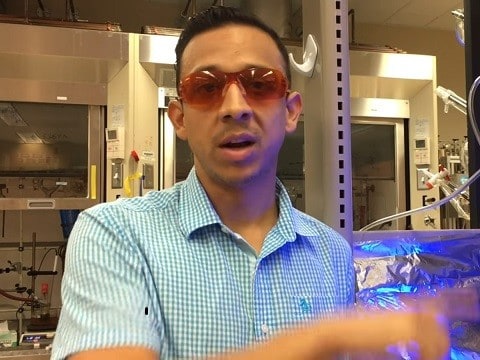
 A team of chemists from the University of Central Florida has invented a form of artificial photosynthesis, one which can convert the greenhouse gas carbon dioxide into energy.
A team of chemists from the University of Central Florida has invented a form of artificial photosynthesis, one which can convert the greenhouse gas carbon dioxide into energy.
The production of CO2 has been identified as the cause of climate change, as the burning of fossil fuels pumps more and more carbon dioxide into the atmosphere further strengthening its ability to retain the sun’s heat once it reaches the Earth.
Scientists have long been curious about the possibility of copying the natural process of photosynthesis that bacteria, algae and plants have been using for billions of years to take the sun’s energy and transform it into a usable fuel source. But so far, investigation into synthetic photosynthesis has been stalled by the fact that the materials that can potentially serve as catalysts for the reaction are mostly expensive ones like platinum and iridium.
For the new discovery researchers developed a synthetic material called a metal-organic framework (MOF) made of the common metal titanium and organic molecules to form a molecular structure with a honeycomb pattern found throughout. The empty spaces in the honeycomb are the key, says Fernando Uribe-Romo, of UCF’s Department of Chemistry and lead author of the new study.
“That empty space, we can use it to store gasses, to do chemical reactions inside,” says Uribe-Romo, “In this case, we’re using it to diffuse carbon dioxide and using sunlight to promote the reduction of that carbon dioxide.”
The team exposed their MOF to blue light (one of the light wavelengths found in sunlight) from an LED photoreactor and found that the light turned the captured CO2 into formate and formamides, two forms of carbon that can be used as fuel sources.
The process, as it does in natural photosynthesis, effectively accomplishes two jobs at once, producing an energy source from readily available sunlight all the while cleaning the air of excess carbon dioxide.
“The idea would be to set up stations that capture large amounts of CO2, like next to a power plant. The gas would be sucked into the station, go through the process and recycle the greenhouse gases while producing energy that would be put back into the power plant,” said Uribe-Romo in a press release.
Artificial photosynthesis and solar energy systems in general have been progressing in leaps and bounds of late, with advances in fuel cell technology and continuing reductions in manufacturing costs driving the market. The year 2015 marked a milestone as more people were employed worldwide in the production of renewable energy than in oil and gas extraction. Over 260,000 people are now employed in the solar industry in the United States, more than double that from 2010 figures.
According to a new report from industry analyst Analytica Advisors, Canada’s clean tech sector is currently suffering, however, with many companies having trouble raising financing. “We can’t count on this sector as part of the positive side of the transition to a low carbon economy unless the companies get access to capital, and unless the capital comes not just from public sector but the private sector,” said Celine Bak of Analytica Advisors. The one notable exception has been energy providers that are profiting by selling power back into provincial energy grids.
Below: Fernando Uribe-Romo on Synthetic Photosynthesis
Leave a Reply
You must be logged in to post a comment.



 Share
Share Tweet
Tweet Share
Share




Comment